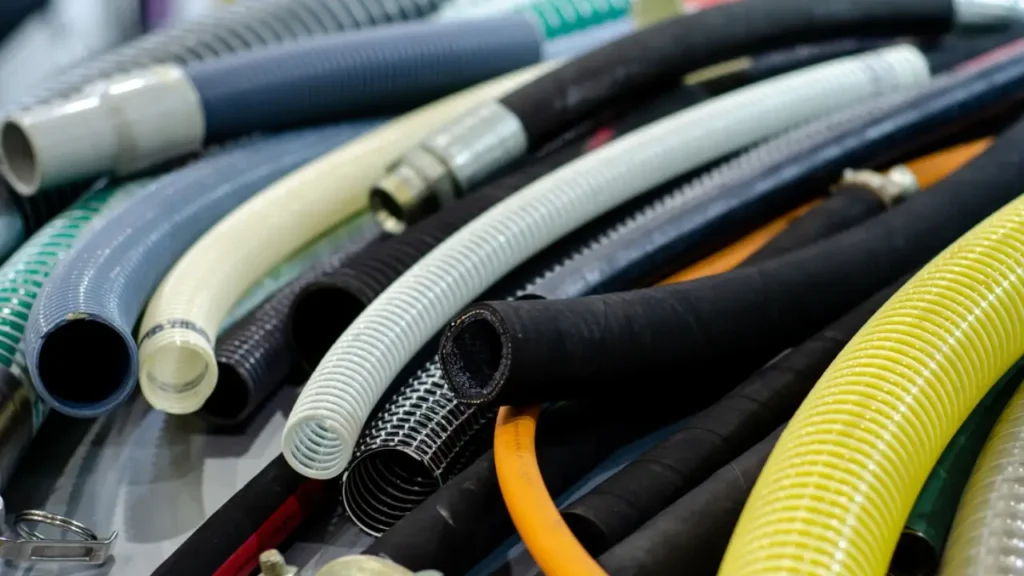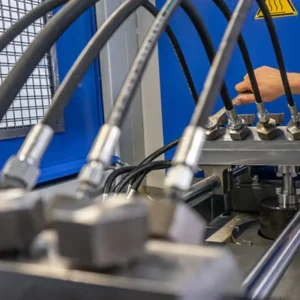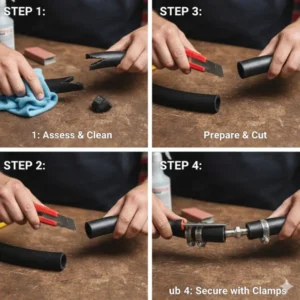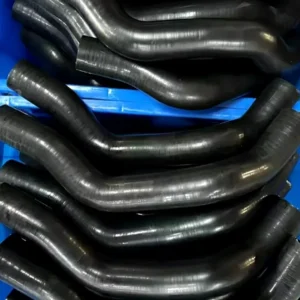Selecting the correct rubber hose is essential for safety, efficiency, and system longevity. Choosing the wrong type can lead to costly failures, leaks, or even catastrophic bursts. This comprehensive guide breaks down the most common hose compounds—like EPDM, Nitrile, and Silicone—and explains how to match them to the demands of your specific application.
Don’t let your process be crippled by a material mismatch. A successful installation depends on accurately assessing the media, temperature, and pressure requirements. Use the expert advice in this blog to confidently navigate the technical specifications, ensuring your fluid transfer system performs reliably and withstands harsh operating environments.
What is a Rubber Hose?
A rubber hose is a flexible conduit designed to transport various media, including liquids, gases, and powders, across different industrial and domestic settings. Its fundamental purpose is to combine the strength of a rigid pipe with the versatility and movement capabilities of a flexible connector.
Rubber hoses are engineered products typically constructed in layers to withstand high pressures, extreme temperatures, and chemical exposure. The design is specialized, ensuring that each component—the inner tube, reinforcement, and outer cover—works together for maximum durability and safety in its specific application.
- Structure: A typical rubber hose consists of three distinct, layered components. These layers are vulcanized (cured) together during manufacturing to form a single, robust, and inseparable structure. This multi-layered design dictates the hose’s working pressure and flexibility.
- Inner Tube: This innermost layer, known as the liner, determines the hose’s chemical compatibility with the fluid it transfers. It must be non-reactive to the conveyed media (oil, steam, chemical, air) to prevent swelling or degradation, which could quickly lead to system failure.
- Reinforcement: This critical middle layer provides the necessary mechanical strength to handle internal pressure and vacuum. It is often made from braided fibers (textile) or spiraled steel wire, which prevents the hose from bursting or collapsing under high stress conditions.
- Outer Cover: The outermost layer is a protective shield designed to resist external environmental threats. These threats include abrasion (dragging), UV radiation, ozone exposure, and incidental contact with oil or grease, thus protecting the structural reinforcement from damage.
Rubber Hose Types

Understanding the various rubber hose types is crucial for making the right selection in industrial and commercial operations. Each hose is specifically engineered with a unique combination of materials and construction to safely handle different mediums, pressures, and environmental challenges. Choosing the right one ensures efficiency and prevents costly failures.
This section provides an overview of the most common rubber hose categories, detailing their primary function and the core material compounds that grant them their specific performance characteristics. Matching these types to your application’s demands is key to system longevity.
Hydraulic Rubber Hoses
Hydraulic Rubber Hoses are the workhorses of fluid power systems, responsible for transferring high-pressure hydraulic fluid (oil) between pumps, valves, and actuators. Their primary feature is their immense pressure rating, often achieved through multiple layers of high-tensile steel wire reinforcement.
These hoses feature an inner tube typically made of Nitrile (NBR) or other synthetic oil-resistant rubber to maintain integrity when constantly exposed to petroleum-based fluids. The outer cover is designed for high abrasion resistance to protect the underlying wire reinforcement from external wear and tear.
- Benefits: Exceptional pressure handling; high resistance to petroleum-based fluids; minimal volume expansion under load.
- Uses: Construction equipment (excavators, loaders); factory machinery; mining equipment; lifting and jacking systems.
Air and Multipurpose Rubber Hoses
Air and Multipurpose Rubber Hoses are primarily designed to convey compressed air, but the multipurpose category can also handle water, mild chemicals, and some non-petroleum-based fluids. They are characterized by lighter construction and greater flexibility than their hydraulic counterparts, often using textile braid reinforcement.
Common materials for these hoses include EPDM or SBR blends for good weathering and ozone resistance, especially in outdoor or garage environments. Their covers are typically abrasion-resistant to withstand being dragged across floors and work sites, where high flexibility is a necessity.
- Benefits: High flexibility and lightweight design; good resistance to weathering and ozone; cost-effective for general use.
- Uses: Pneumatic tools; general plant air lines; shop clean-up; light-duty water transfer and washdown.
Chemical Transfer Rubber Hoses
Chemical Transfer Rubber Hoses are engineered to safely transport corrosive liquids, acids, alkalis, and solvents. Chemical compatibility is the most critical factor, requiring the inner tube material to be virtually inert to the conveyed substance to prevent catastrophic chemical leaks.
The liner is often made of specialized polymers like UHMWPE (Ultra-High Molecular Weight Polyethylene), PTFE (Teflon), or highly resistant synthetic rubbers like Hypalon. The cover is also designed to resist corrosive spillage and harsh atmospheres, often featuring static-dissipative components for safety.
- Benefits: Near-universal chemical resistance (depending on liner); excellent safety against spills; high durability in corrosive environments.
- Uses: Transfer of strong acids and bases; chemical processing plants; hazardous waste management; solvent delivery.
Steam Rubber Hoses
Steam Rubber Hoses are specifically built to withstand the extreme temperatures and high pressures associated with saturated or superheated steam in industrial cleaning and processing applications. Failure in a steam hose is highly dangerous, demanding a robust and thermally stable construction.
The interior and exterior are generally made from EPDM compounds, which exhibit superior heat and moisture resistance compared to other rubbers. They are reinforced with layers of high-tensile steel wire or fabric plies to handle the inherent pressure spikes and thermal cycling.
- Benefits: Superior heat resistance; designed for high-pressure saturated steam; excellent resistance to thermal aging and moisture.
- Uses: Sterilization (autoclaves); heavy-duty industrial cleaning; steam tracing and heating lines; rubber vulcanization.
Material Handling Rubber Hoses
Material Handling Rubber Hoses, also known as abrasive or slurry hoses, are designed for conveying solid, abrasive materials like cement, sand, gravel, fly ash, and food particles. The primary design focus is on providing an extremely durable inner tube to resist wear and tear from friction.
The inner liner is often made of thick, pure Natural Rubber (Gum Rubber), which provides exceptional elasticity and abrasion resistance. The covers are thick and rugged, protecting the hose from crushing and impact damage common in mining and construction material transfer.
- Benefits: Maximum resistance to internal abrasion and cutting; thick wall construction for long service life; handles both suction and discharge.
- Uses: Mining slurry; concrete and sand blasting; dry cement and fly ash transfer; grain and seed transfer in agriculture.
Food and Beverage Rubber Hoses
Food and Beverage Rubber Hoses are specialized hoses used in processing plants to transfer liquids and dry goods intended for human consumption (e.g., dairy, beer, wine, edible oils). The key requirement is that all materials must be FDA-approved and non-contaminating.
Liners are typically made of high-purity, white EPDM, Buna-N, or Silicone that is smooth, non-porous, and odorless to prevent bacterial growth and not impart taste to the product. They are designed to withstand high-temperature Clean-In-Place (CIP) washdowns and sterilization.
- Benefits: FDA-compliant and sanitary; smooth bore for easy cleaning; non-tainting and non-porous; highly flexible.
- Uses: Transfer of milk, beer, wine, and liquor; conveying dry food ingredients (sugar, flour); processing edible oils.
Automotive Rubber Hoses
Automotive Rubber Hoses are found under the hood, managing cooling, heating, vacuum, and fuel systems. They must operate reliably within a confined space while enduring constant vibration, oil mist, and wide temperature swings from engine operation.
The two main types are radiator/heater hoses, usually made from EPDM for coolant resistance, and fuel/oil lines, which use Nitrile or HNBR for hydrocarbon resistance. Their covers must also be ozone-resistant due to the harsh, aged environment of the engine bay.
- Benefits: Resistant to automotive fluids and heat; flexible for tight engine routing; long-term durability against ozone and weathering.
- Uses: Engine cooling systems (radiator and heater lines); fuel injection and return lines; turbocharger connections; vacuum lines.
Water Rubber Hoses (General Purpose)
Water Rubber Hoses (General Purpose) are the most common and least specialized, designed for conveying plain water at low to moderate pressures for agricultural, garden, or utility purposes. They prioritize flexibility, cost-effectiveness, and UV resistance for outdoor use.
General water hoses often utilize PVC (Polyvinyl Chloride) or a blend of SBR and EPDM. Reinforcement is typically a single or double ply of synthetic textile cord. They are not suited for hot water, chemicals, or high-pressure steam applications.
- Benefits: Lightweight and easy to handle; good weather and abrasion resistance; inexpensive for simple water transfer.
- Uses: Lawn and garden watering; construction site de-watering; utility water feed; agricultural spray lines.
Silicone Rubber Hoses
Silicone Rubber Hoses are specialty products valued primarily for their ability to function across an extreme temperature range, from very cold to very high heat, far exceeding standard organic rubbers. They are inherently flexible and maintain their properties well.
These hoses are often found in performance automotive turbocharger systems (intercooler hoses) or high-temperature ducts because of their excellent resistance to thermal cycling, ozone, and UV light. Their reinforcement is usually a polyester or aramid fabric ply.
- Benefits: Withstands extreme temperature (−50∘C to +200∘C); excellent ozone and UV resistance; highly flexible even when cold.
- Uses: High-performance vehicle coolant and air intake systems; hot air transfer ducts; aerospace and medical equipment.
Ducting Rubber Hoses
Ducting Rubber Hoses are designed to convey large volumes of air, fumes, light dust, or abrasive materials in ventilation and extraction systems. Their structure is focused on maintaining an open, uncollapsed pathway, often under vacuum conditions.
They are typically constructed as a flexible fabric or film (such as PVC or coated textile) held open by a visible external wire helix reinforcement. The material selection depends on whether the hose needs to be heat-resistant, chemical-resistant, or static-dissipative.
- Benefits: Excellent flexibility and crush resistance; lightweight; high capacity for air and light material flow; supports vacuum.
- Uses: Fume exhaust and ventilation; dust collection systems; wood shop sawdust extraction; light material conveyance.
Table of Rubber Hose Types and Materials
| Hose Type | Primary Medium | Key Inner Tube Material | Key Reinforcement | Core Performance Feature |
| Hydraulic Rubber Hoses | High-Pressure Oil | Nitrile (NBR) | Steel Wire Braid/Spiral | Extreme Pressure Rating |
| Air / Multipurpose Rubber Hoses | Compressed Air, Water | EPDM / SBR | Textile Braid | Flexibility, Weather Resistance |
| Chemical Transfer Rubber Hoses | Corrosive Fluids, Acids | UHMWPE / PTFE / Hypalon | Fabric Plies, Wire Helix | Chemical Inertness |
| Steam Rubber Hoses | Saturated/Superheated Steam | EPDM | Steel Wire Braid | High Temperature & Pressure |
| Material Handling Rubber Hoses | Slurries, Sand, Gravel | Natural Rubber (NR) | High-Tensile Textile Plies | Extreme Abrasion Resistance |
| Food & Beverage Rubber Hoses | Dairy, Wine, Edible Oils | White FDA EPDM / NBR | Textile Braid | Non-Toxic, Cleanability (CIP) |
| Automotive Rubber Hoses | Coolant, Fuel, Oil | EPDM / Nitrile (HNBR) | Fabric Plies | Thermal & Ozone Resistance |
| Water (Utility) Rubber Hoses | Low-Pressure Water | SBR / PVC | Textile Braid | Cost-Effective, UV Resistance |
| Silicone Rubber Hoses | High-Temp Air/Fumes | Silicone | Polyester/Aramid Fabric | Extreme Temperature Range |
| Ducting Rubber Hoses | Air, Fumes, Light Dust | PVC / Coated Fabric | External Wire Helix | Vacuum Stability |
| Marine Rubber Hoses | Exhaust, Fuel, Water | Nitrile / EPDM | Wire Helix / Fabric Plies | Saltwater and Oil Resistance |
How to Choose Suitable Rubber Hoses for Your Project?
Choosing the right rubber hose requires a systematic approach based on the application’s demands. Improper selection risks dangerous failures, costly downtime, and potential damage. Use the industry-standard S.T.A.M.P.E.D. criteria to evaluate every factor from the media being conveyed to the fittings required, ensuring safety and optimal performance.
This comprehensive framework helps engineers and technicians match the hose specifications to the operating environment. By carefully assessing these critical parameters, you can confidently select a hose assembly that resists chemical attack, handles pressure and temperature extremes, and provides the necessary flexibility and lifespan.
- Size (S): Determine the inner diameter (ID) and length needed. The ID must be accurately sized to maintain the required flow velocity; too small leads to excessive pressure drop and heat, while too large is inefficient and costly. Length must allow for movement.
- Temperature (T): Consider the temperature of the fluid being transferred and the ambient external temperature. The hose material’s rating must withstand the maximum of both. High temperatures degrade rubber quickly, leading to stiffening or softening and eventual catastrophic failure.
- Application (A): Evaluate the working conditions, including frequency of use, routing constraints, and external forces. Does the hose experience constant flexing, vibration, or dragging? This dictates the required flexibility, bend radius, and external cover durability.
- Media (M): Identify the fluid or material conveyed. Compatibility is paramount. The inner tube material must resist the chemical properties of the media (oil, steam, corrosive acid, foodstuff) to prevent erosion, swelling, or breakdown, which contaminates the flow and destroys the hose.
- Pressure (P): Establish the maximum working pressure, including any potential surge or impulse spikes. Select a hose with a rated working pressure that exceeds your system’s maximum operating pressure by a safe margin, usually incorporating a 4:1 safety factor to prevent sudden bursts.
- Ends (E): Choose the correct fittings, couplings, or connectors needed for installation. The end style and material must match the hose type, pressure rating, and chemical media. Improper fitting attachment is a leading cause of hose assembly leaks and failure.
- Delivery (D): Account for assembly, testing, quality assurance, and supplier lead times. Consider minimum order quantities and the availability of replacement parts. Partnering with a reliable supplier like Gushan Rubber ensures timely, certified, and cost-effective delivery of bulk hoses.
Conclusion
Choosing the right rubber hose requires careful consideration of the S.T.A.M.P.E.D. criteria: Size, Temperature, Application, Media, Pressure, Ends, and Delivery. By systematically evaluating your operational environment and the chemical compatibility of the hose’s inner tube, you can prevent premature degradation, ensure maximum fluid flow, and significantly reduce downtime due to failure.
A quality hose is a vital investment in your system’s reliability. Whether you need oil-resistant Nitrile, weather-proof EPDM, or high-heat Silicone, selecting a durable, properly reinforced product is key. Ensure your bulk purchases meet stringent industry standards for both performance and longevity, protecting your assets and personnel for years to come.
Ready to secure the highest-quality hoses for your industrial needs? Don’t compromise on the materials that keep your operations running smoothly. Contact Gushan Rubber today to discuss your specifications and get wholesale rubber hoses directly from our expertly engineered and comprehensive inventory.




